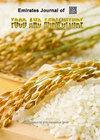磷酸盐丁酰化桄榔淀粉生物塑料的理化和感官特性
IF 0.7
4区 农林科学
Q3 AGRONOMY
引用次数: 0
摘要
本研究的目的是根据生物塑料产品的理化和感官特性,确定磷酸盐丁酰化安加淀粉(PBAS)的最佳浓度。PBAS 是通过使用 5% 丁酸酐丁基化和使用 6% 的三聚磷酸钠(STMP)和三聚磷酸钠(STPP)混合物以 99:1 的比例(重量比)交联,对原生安哥淀粉进行双重改性而得到的。所测试的 PBAS 浓度分别为 4.7%、5.0%、5.3%、5.7%、6.0%、6.3%、6.7%、7.0% 和 7.3%(w/v),共使用了 27 个实验单位。研究了厚度、持水率(WHC)、持油率(OHC)、膨胀力、溶解度、水蒸气透过率(WVTR)、含水率、pH 值、生物降解和感官特性。结果表明,生物塑料的厚度、溶解度、水蒸气透过率和含水量随着 PBAS 浓度的增加而增加。另一方面,随着 PBAS 浓度的增加,生物塑料的 WHC 和 OHC、膨胀力、pH 值和生物降解性都有所下降。生物塑料的感官颜色随着 PBAS 浓度的增加而增加,而质地、香气和总体可接受性则随着 PBAS 浓度的增加而降低。从较低的 WVTR 和含水量以及小组成员对生物塑料质地的偏好来看,7.0% 的 PBAS 浓度是生物塑料理化和感官特性的最佳浓度。 关键词磷酸盐丁酰基化熊果淀粉;生物塑料的物理化学;生物塑料的感官。本文章由计算机程序翻译,如有差异,请以英文原文为准。
Physicochemical and sensory characteristics of bioplastics from phosphate butyrylated arenga starches
The aim of this study was to obtain the optimum concentration of phosphate butyrylated arenga starches (PBAS) of bioplastic based on the physicochemical and sensory properties. The PBAS was obtained by dual modification of native arenga starch through butyrylation using 5% butyric anhydride and crosslinking using 6% a mixture of sodium trimetaphosphate (STMP) and sodium tripolyphosphate (STPP) at 99:1 (w/w). The concentration of the PBAS tested varied at 4.7; 5.0; 5.3; 5.7; 6.0; 6.3; 6.7; 7.0; and 7.3% (w/v) with three replications so that there were 27 experimental units used. The thickness, water holding capacity (WHC), oil holding capacity (OHC), swelling power, solubility, water vapor transmission rate (WVTR), water content, pH, biodegradation and properties of sensory were investigated. Results showed that the thickness, solubility, WVTR and water content of bioplastics increased with the increase in the concentrations of PBAS. On the other hand, WHC and OHC, swelling power, pH, and biodegradation decreased along with the increase in PBAS concentrations. Sensory color of bioplastics increased, while texture, aroma and overall acceptability decreased with the increase in PBAS concentrations. The concentration of PBAS at 7.0% was optimum for the physicochemical and sensory properties of bioplastics as indicated by low WVTR and water content as well as panelist preference on bioplastic texture. Keywords: Phosphate butyrylated arenga starches; Physicochemical of bioplastic; Sensory of bioplastic.
求助全文
通过发布文献求助,成功后即可免费获取论文全文。
去求助
来源期刊

Emirates Journal of Food and Agriculture
AGRONOMYFOOD SCIENCE & TECHNOLOGY&nb-FOOD SCIENCE & TECHNOLOGY
CiteScore
1.80
自引率
0.00%
发文量
18
期刊介绍:
The "Emirates Journal of Food and Agriculture [EJFA]" is a unique, peer-reviewed Journal of Food and Agriculture publishing basic and applied research articles in the field of agricultural and food sciences by the College of Food and Agriculture, United Arab Emirates University, United Arab Emirates.
 求助内容:
求助内容: 应助结果提醒方式:
应助结果提醒方式:


